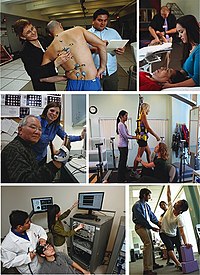
Photo from wikipedia
OBJECTIVE Quantitative diffusion tensor imaging (DTI) of skeletal muscles is challenging due to the bias in DTI metrics, such as fractional anisotropy (FA) and mean diffusivity (MD), related to insufficient… Click to show full abstract
OBJECTIVE Quantitative diffusion tensor imaging (DTI) of skeletal muscles is challenging due to the bias in DTI metrics, such as fractional anisotropy (FA) and mean diffusivity (MD), related to insufficient signal-to-noise ratio (SNR). This study compares the bias of DTI metrics in skeletal muscles via pixel-based and region-of-interest (ROI)-based analysis. METHODS DTI of the thigh muscles was conducted on a 3.0-T system in N = 11 volunteers using a fat-suppressed single-shot spin-echo echo planar imaging (SS SE-EPI) sequence with eight repetitions (number of signal averages (NSA) = 4 or 8 for each repeat). The SNR was calculated for different NSAs and estimated for the composite images combining all data (effective NSA = 48) as standard reference. The bias of MD and FA derived by pixel-based and ROI-based quantification were compared at different NSAs. An "intra-ROI diffusion direction dispersion angle (IRDDDA)" was calculated to assess the uniformity of diffusion within the ROI. RESULTS Using our standard reference image with NSA = 48, the ROI-based and pixel-based measurements agreed for FA and MD. Larger disagreements were observed for the pixel-based quantification at NSA = 4. MD was less sensitive than FA to the noise level. The IRDDDA decreased with higher NSA. At NSA = 4, ROI-based FA showed a lower average bias (0.9% vs. 37.4%) and narrower 95% limits of agreement compared to the pixel-based method. CONCLUSION The ROI-based estimation of FA is less prone to bias than the pixel-based estimations when SNR is low. The IRDDDA can be applied as a quantitative quality measure to assess reliability of ROI-based DTI metrics.
Journal Title: European journal of radiology
Year Published: 2018
Link to full text (if available)
Share on Social Media: Sign Up to like & get
recommendations!